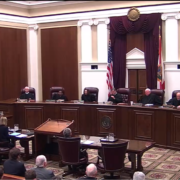Is A Tampa Bay Collaborative Divorce Quicker Than A Courtroom Divorce?
Whenever a potential divorce client comes to my Tampa office, I always make sure to discuss the various process options for dissolving his or her marriage in Florida.
I discuss the litigation option, where the parties battle it out in a courtroom and let a judge decide how to divide their assets and raise their children. I discuss the mediation option, a form of alternative dispute resolution where the parties may resolve the entire dispute themselves, but where the parties and their attorneys always leave the option open of going back into courtroom battle mode.
And I discuss the collaborative option, where the spouses, and their attorneys, agree from the beginning that they are not going to let a judge decide personal, private matters such as who is going to tuck their children into bed at night; rather the spouses and their attorneys are going to act like adults, and respectfully and privately come to an agreement on important issues such as how to raise their children.
One of the most frequent questions I am asked when discussing the different divorce methods is which option is the quickest.
Though the timing of each option depends on the ability of the parties to communicate, among other factors, I have found the following to be true in my practice: All of my Collaborative Divorce cases have been resolved more quickly than any of my litigation or mediation cases.
There are several reasons why this may be the case.
First, neutral facilitators, who are generally licensed mental health professionals, act as case managers. Not only do they ensure that spouses speak to one another respectfully, but they keep parties focused on the future rather than stay bogged down in the arguments of the past. This forward-looking view helps the parties stay attentive to what is important to them, such as the well-being of their children, and thus helps propel the process to completion more quickly. Further, they ensure that, at the end of each meeting, the next meeting is scheduled. This means that collaborative divorce cases do not languish, and the professionals are always concentrating on the next task at hand to progress the parties’ interests.
Second, neutral financial professionals are able to gather and analyze the required financial information and documents much more quickly than attorneys can. Moreover, based on their financial experience, they tend to be able to develop tailor-made options much more rapidly that address both clients’ future needs.
Third, in collaborative divorce cases, agendas are used for all meetings. The agendas are created by the parties’ attorneys with the input of clients and help of facilitators and financial professionals. This ensures that all issues that are important to clients are addressed in a sequence which is most likely to lead to final settlement. Easier topics generally are addressed first, which help clients gain trust towards one another and show that they are acting in good faith, and more difficult topics are addressed later, once more information is gathered and the parties are able to make fully-informed decisions.
Though all of my collaborative cases have settled more quickly than any of my other cases once a collaborative participation agreement was signed, every case is different. It is possible for a Florida collaborative divorce case to take longer. However, I do not think that my track record on collaborative divorce cases is by coincidence.
If you have questions on how the Tampa Bay collaborative divorce process can help your family, schedule a consultation with a Florida collaborative attorney at (813) 443-0615 or by filling out our contact form.
Adam B. Cordover is President of Next Generation Divorce, a practice group of attorneys, mental health professionals, and financial professionals dedicated to helping families resolve their disputes through the private, respectful collaborative process.




Leave a Reply
Want to join the discussion?Feel free to contribute!